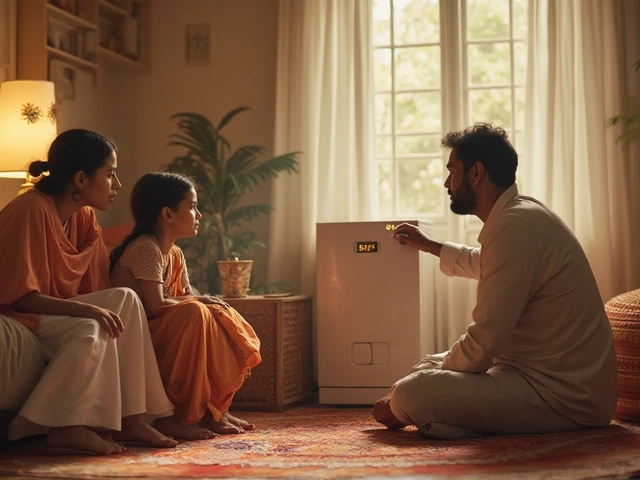Trying to decide whether to repair or replace your refrigerator? You're not alone. Many folks find themselves in the same dilemma, especially when dealing with unexpected appliance issues. But before emptying your wallet, let's weigh the options.
First up, consider the repair costs. On average, fixing a fridge might set you back around $200 to $400. But here's a kicker: If your fridge is over ten years old, repairs might not be worth it. Why? Older fridges tend to gobble up energy and may continue to break down over time. If it's a younger model and the issue's minor, repair could be your best bet.
On the flip side, replacing a fridge can cost anywhere from $500 to $3,000, depending on the size and features you want. Sure, a new fridge will be more energy-efficient, but that initial sticker shock is hard to ignore. Plus, don't forget to account for delivery and installation fees.
- Understanding Repair Costs
- Evaluating Replacement Expenses
- Factors Influencing Decision
- Practical Maintenance Tips
Understanding Repair Costs
When it comes to fridge repair, the price tag can make a big difference to your decision. Now, what's really involved in those repair costs?
Generally, repair costs break down into parts and labor. The part that needs replacing often dictates the price. For instance, if it's a simple thermostat or a door seal, you might get away with $50 to $100. But if it’s the compressor, brace yourself for a heftier bill, possibly running up to $500.
Labor Costs
Don’t forget labor! Professional technicians typically charge between $45 and $120 per hour. The total cost depends on how complex the problem is and the going rates in your area. Most repairs can be done in an hour or two, but some more intricate issues might take longer—and more dollars.
Is It Worth It?
If your fridge is a newer model, a repair might be worth it. It can extend the appliance's lifespan without breaking the bank. However, if your fridge is on the older side, consider how often it's breaking down and its energy use.
Here's a quick rule of thumb: If the repair costs more than half the price of a new refrigerator, it might be time to start shopping for a replacement.
| Component | Estimated Repair Cost |
|---|---|
| Thermostat | $50 - $200 |
| Door Seal | $60 - $100 |
| Ice Maker | $250 - $330 |
| Compressor | $400 - $500 |
Knowing these figures can help you decide whether to dive into repairs or start browsing for a new refrigerator replacement.
Evaluating Replacement Expenses
So, you're considering ditching the old fridge for a brand spanking new one? Let's dive into what that might cost you. It's not just about the price tag on the shiny new model; there's more to it.
First, consider the range. A mid-range refrigerator can cost anywhere between $700 and $1,500, which typically includes basic features like adjustable shelves and decent capacity. If you want to splurge on a high-tech model with smart features, be prepared to spend over $2,000. Those touchscreens don't come cheap!
Additional Costs to Consider
Outside the cost of the fridge itself, don't forget the extras:
- Delivery Fees: Many places charge around $50 to $100 for delivery.
- Installation Fees: If you can't install it yourself, hiring a pro might add another $100 to $200.
- Old Fridge Removal: Need the old one taken away? That's usually an extra $30 to $50.
Energy Efficiency Matters
Thinking green? New fridges are way more energy-efficient. An Energy Star-certified model can save you up to $150 over the appliance's lifetime. Over ten years, those savings add up, softening the blow of that initial cost.
Here's a fun fact: Modern fridges use about 40% less energy compared to models from the early 2000s. That's good news for your electricity bill!
Long-Term Investment
Lastly, think of your new fridge as an investment. A reliable refrigerator can last 10 to 20 years. Choosing a model with a longer warranty might cost more upfront, but it could save you heaps later if problems crop up. So while the replacement costs might seem daunting, considering the long-term benefits might make it a worthy expense.

Factors Influencing Decision
Deciding whether to repair or replace your refrigerator isn't just about dollars and cents. Several factors can steer your choice in one direction or the other. Let's break it down.
Age of the Fridge
The age of your appliance is a biggie. Generally, if your fridge is over 10 years old, it may be time to start looking for a replacement. Older models typically use more energy and can become money pits with repeated repairs.
Energy Efficiency
Newer appliances come with energy-efficient technologies that could save you money on electricity bills over time. A new fridge might have an Energy Star rating which means it's not only kinder to your wallet but also to the environment.
Cost of Repairs
If you get a repair estimate, and it's more than half the cost of a new fridge, replacing might be your better bet. For simpler fixes, like a faulty thermostat or a broken door seal, repairs can be pretty affordable and worthwhile.
Current Features versus Needs
Sometimes, our needs evolve. If you're stuck with a tiny fridge that can't fit your family's weekly groceries, upgrading to a bigger, feature-rich model might make sense. However, if your current fridge meets your needs perfectly aside from a minor issue, repairing could be the way to go.
| Factor | Consideration |
|---|---|
| Fridge Age | Over 10 years? Think replacement. |
| Energy Efficiency | New models have cost-saving features. |
| Repair Costs | More than 50% of a new fridge? Consider replacing. |
Warranty
Don't forget about the warranty. If your fridge is still under warranty, most repairs could be covered, saving you a bundle. Review your documentation to see what's included.
Practical Maintenance Tips
Keeping your fridge in top shape can save you a bundle in the long run. Here are some practical steps you can take to prolong its life and avoid costly fridge repair.
Regular Cleaning
One of the simplest things you can do is clean your fridge regularly. A dirty condenser coil is a common culprit that makes your fridge work harder, which you don't want. Make sure to clean these coils, usually found at the back or bottom, every six months.
Check the Door Seals
Door seals, or gaskets, ensure your refrigerator stays cold. Cracked or loose seals allow cold air to escape, meaning your fridge has to work overtime. Test the seals by placing a piece of paper halfway in the door and closing it. If it slips out easily, it might be time to replace the seals.
Temperature Settings
Setting the right temperature is key for efficiency. Keep your refrigerator around 37°F (3°C) and your freezer at 0°F (-18°C). These settings ensure food stays fresh without overworking the appliance.
Organized Storage
Overstuffing your fridge can block airflow, making it harder to maintain the right temperature. Keep things organized so air circulates freely. It helps to label food and avoid pushing things too far back where they might go unnoticed.
Listen for Strange Noises
Weird noises aren't just annoying—they might signal something is wrong. If you hear things like rattling or hissing, it's best to call a professional. Tackling potential issues early could save you from needing refrigerator replacement.
| Maintenance Task | Recommended Frequency |
|---|---|
| Cleaning Coils | Every 6 months |
| Checking Door Seals | Every 3 months |
| Temperature Check | Monthly |



